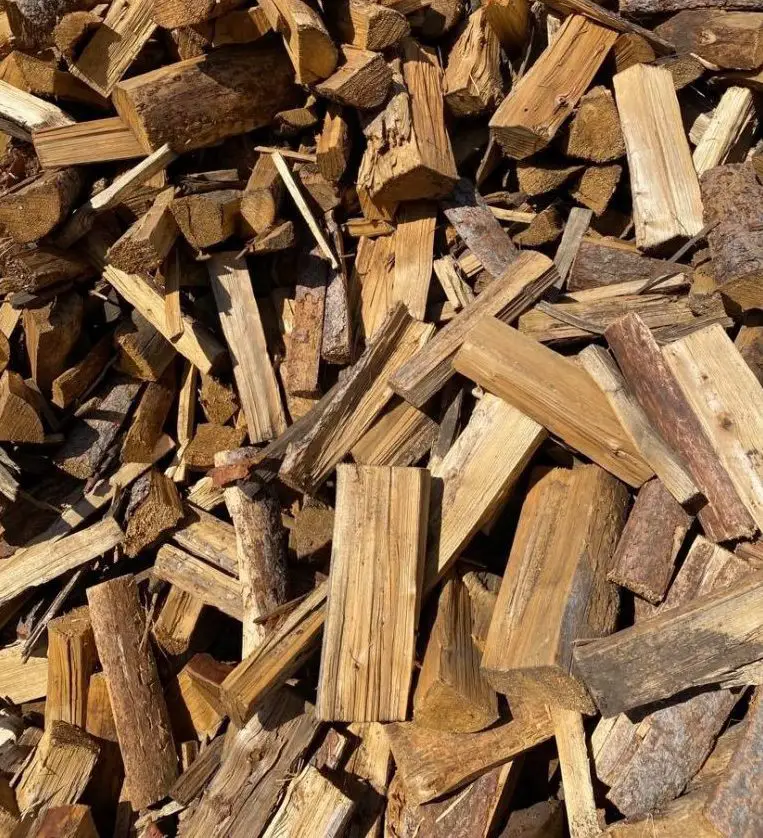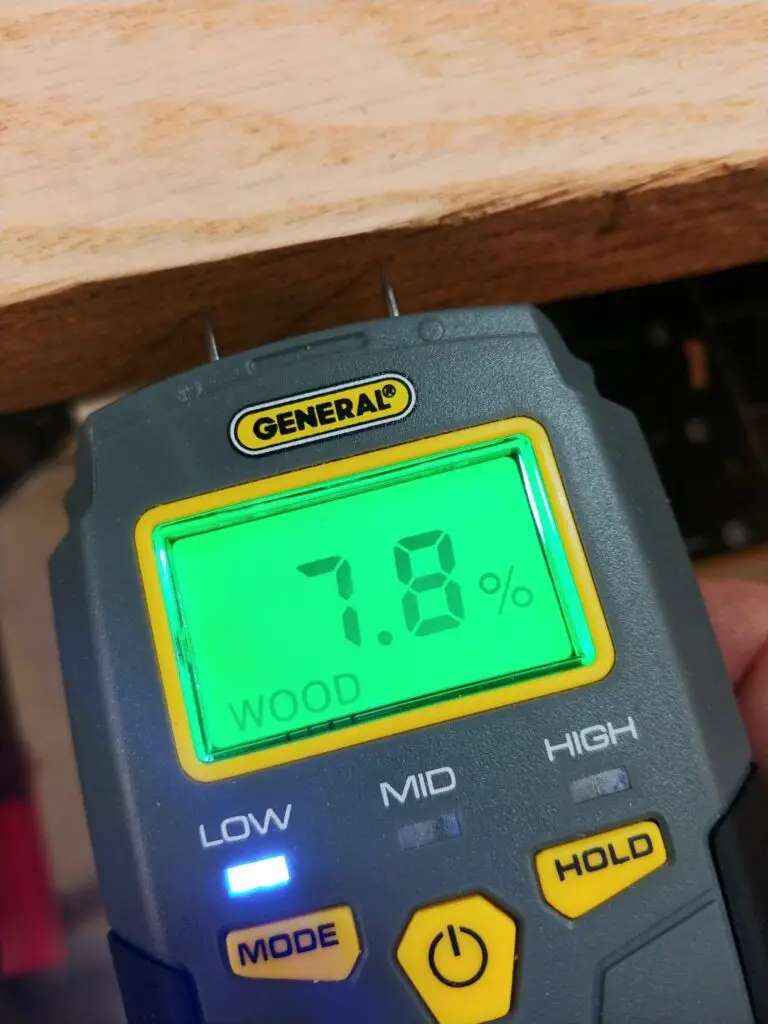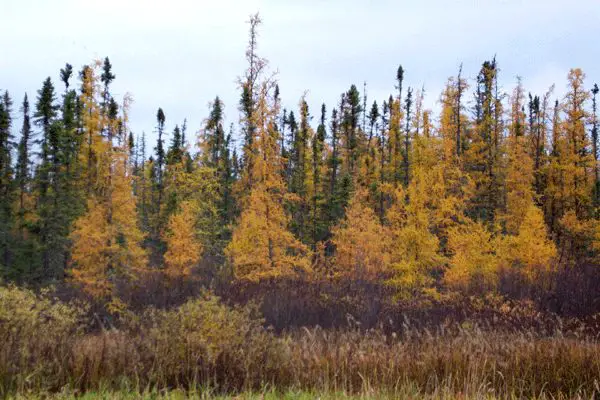Larch is moderate firewood due to its lower heat production, but its quick ignition makes it well suited for use as kindling. Compared to other softwoods it has higher heat production and is easy to light, making it the best softwood firewood. It is described as a ‘hard softwood’ that gives it special characteristics.
However, it does burn with a lot of popping due to its sap content and can be more difficult to split than other softwood species. Overall I rate larch firewood as a moderate firewood, especially compared to premium hardwood like oak.
Let’s have a look at larch firewood’s unique characteristics.
Table of Contents
Summary
- BTU: 21.8 million BTU/cord
- Weight: 3300 lb/cord dry
- Seasoning Time: 6-12 months
- Splitting Difficulty: Moderate
- Sap Content: Moderate
- Smoke: Low
- Smell: Strong
Overall, I rate larch as a moderate firewood. It has a good combination of being quicker to light than a dense hardwood and burning longer than a softwood. Larch is softwood but has one of the highest heat productions compared to other softwoods, like pine. Larch is considered a ‘dense softwood’, giving it unique characteristics.
However, it does have some downsides – it has a moderate sap content which produces a lot of crackles and pops when burning. It also has a strong fragrance that I personally don’t mind, but you should consider if you are sensitive to smells and don’t want to smoke out your home if burning indoors.

Heat Production
Larch has a very high heat production for a softwood at 21.8 million BTU/cord, which is higher than some hardwoods. It is also easy to light, giving it a combination many people rate as the highest quality softwood to burn. I agree with this, but I can only rate it as a moderate overall firewood when comparing with premium hardwoods.
It also burns with a lot of crackles and pops as individual pockets of sap ignite, which can be problematic if you are burning indoors. Make sure you have a glass screen to prevent any pops from sending sparks into your house.
Smoke Production
Thankfully larch doesn’t produce a lot of smoke, which is surprising considering its higher sap content and strong scent. However, if you burn unseasoned larch, you will experience significantly more smoke production and sap igniting. I always recommend avoiding burning unseasoned wood because of the higher creosote production, smoke generation, and low heat generation.
Seasoning Time
Larch is fast to season and generally only takes 6 to 12 months to entirely season, which is significantly quicker than premium hardwoods. This is one of the key advantages of being a softwood, and means that you can leave your stockpile preparation later in the year. Ensure you stack your firewood correctly to make it dry as fast as possible by leaving gaps between rows, covering the top from rain, and leaving the sides open for sunshine and airflow.
Larch firewood also doesn’t rot as quickly as other softwood species.
I personally recommend this General Tools Moisture Meter. It allows you to accurately gauge how wet your firewood is and whether it is sufficiently seasoned. Over time you can also see how quickly the moisture is dropping and how much longer you need to keep your firewood dropping until it is seasoned and ready to burn.
Press the sharp pins into the wood and you will quickly see the readout show the moisture ranging from 5% to 50%. It also has a Low/Mid/High indication depending on whether the wood is dry enough, so you don’t need to remember the actual values.

Burning Smell
Larch firewood, and in particular Tamarack, does produce a strong smell. I enjoy it myself, but if you are sensitive to smells, you may want to avoid it – especially if you intend to burn indoors and don’t want the smell in your home. It doesn’t produce a lot of smoke, so you can vent the smell easily if you have good ventilation through a chimney or stack.
If you burn unseasoned larch, which I always recommend avoiding, you will notice a lot of smoke, a strong smell, and a lot of sap igniting.
If you are especially interested in odor for smoking meats or if you are sensitive to smell, have a read through this guide I have written about the best smelling firewoods to burn.
Creosote Buildup
Creosote is a black soot that can build up in your chimney that is caused by unburnt wood. It is much more common when burning green softwood. Pine is one of the worst culprits for creosote formation. If enough soot builds up then this can cause chimney fires.
Larch is one of the densest softwoods, producing significantly less creosote than other softwoods such as pine or cedar. As long as you ensure that your larch firewood is fully seasoned, then it doesn’t have any greater chance of producing creosote than premium hardwoods.
I recommend cleaning your chimney regularly, regardless of firewood type, to eliminate this risk completely.
Splitting
Larch trees grow straight and tall, so you get a higher yield per tree than other species, like apple wood. They are relatively easy to split, however, when compared to softer woods it can take some effort. The trees also grow relatively tall, so you may want to consider using a log splitter if you have multiple trees to process.
Different Types/Species
There are 11 different species of larch throughout the world. In this section, I will focus on the three commonly found throughout North America – Tamarack, Subalpine Larch, and Western Larch. Larch is a conifer that grows up to 160 feet tall, particularly in the colder regions worldwide.
Tamarack
Larix laricina, or Amercian larch is found throughout Alaska, Canada, and the northern United States. Tamarack is the most common species in the US, and is what you are likely to receive when buying ‘larch firewood.’
Subalpine Larch
Larix lyallii is found in the northwest of the United States and southwest of Canada, but only at very high altitudes. It is doubtful that you will get access to this larch species because of its difficult to access growing locations.
Western Larch
Larix occidentalis is found at lower altitudes throughout the northwest United States and southwest Canada. It is also much more unlikely to find as a source of firewood compared to Tamarack.

Comparison to Other Woods
Here, I’ve taken some of the most popular firewoods to burn indoors and compared them to larch firewood.
Larch is often described as one of the best softwood firewood, which I would agree with, but when compared to the premium hardwoods, such as oak, larch can only be rated as moderate.
| Firewood | Million BTU/Cord (source) | Ease of Splitting | Coals | Overall Quality |
| Green Ash | 20 | Easy | Good | Excellent |
| Maple | 25 | Easy | Excellent | Excellent |
| Bur Oak | 26 | Easy | Good | Excellent |
| Larch | 22 | Moderate | Moderate | Moderate |
Larch burns hot and fast, so it doesn’t generate the kind of slow-burning coals you prefer for cooking. I find its coals to have an uneven temperature profile that can be difficult to grill on. In the morning, you will find all ash, no coals, so keep this in mind if you want to keep a larch fire burning for multiple days continuously.
FAQs
Can you burn larch wood in a fire pit?
Yes, larch is an ideal firewood for burning outdoors while camping in a fire pit. It burns hot and does contain some sap that ignites and pops, making it well suited for burning outdoors. It also has a strong smell that you may not want to bring into your home. Keep in mind that it is still a softwood, that burns hot and doesn’t leave coals behind. If you intend to cook on larch coals, then you will need to know that you will get an uneven temperature profile.
Can you burn larch wood in a wood stove?
Yes, larch can be burnt indoors and is generally classified as one of the best softwood species for firewood. However, it does burn with crackling and popping due to its sap concentration. You will also find it has a strong smell. Larch wood burns hot and fast so you will need to add more wood to the fire frequently, but its heat production per log is higher than some hardwood alternatives.
How much does larch firewood cost to buy?
Larch firewood is only available in colder climates such as the northwestern states of the USA. It costs around $300 per cord, depending on the location and season. Larch is considered one of the best burning softwoods, so you should consider its higher heat production compared to other softwoods such as pine. It is also significantly cheaper than premium hardwood species like oak while still generating decent heat. Compare the cost of larch firewood to alternate types.
Final Thoughts
Larch firewood, or Tamarack in particular, is one of North America’s best burning softwood species. It has a higher heat production than some hardwoods, seasons quickly, and has a high yield per tree. It is also cheaper than premium hardwoods, like oak, and lights quickly and easily. If you have access to larch firewood, then I recommend adding it to your stockpile.
However, it still has a lower heat production than the best hardwood species, meaning that you will have to store an additional 15-20% to produce the same heat throughout the entire winter. It also pops with sap igniting and creates a strong scent, so you may want to avoid it for indoor use.
